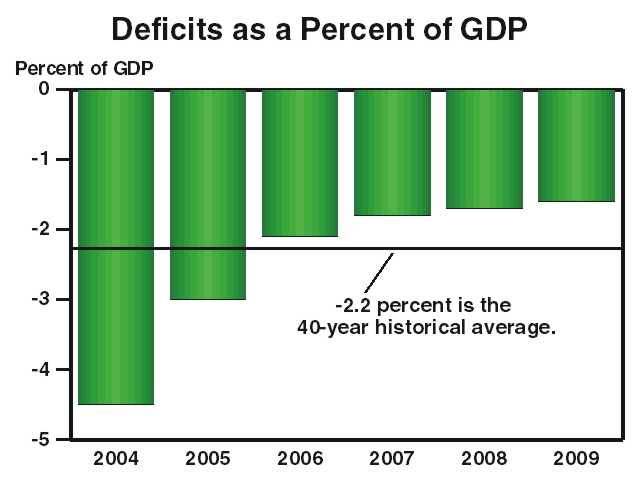 |
||||||
|
||||||
| |||||||||||||||||
|
|
|||||||||||||||||
The President’s 2005 Budget continues to support and advance three overriding national priorities: winning the war on terror, protecting the homeland, and strengthening the economy.
The President is committed to spending what is necessary to provide for our security––and restraining spending elsewhere. Since September 11, 2001, more than three-quarters of the increase in discretionary spending has been directly related to our response to the attacks, enhanced homeland security, and the War on Terror. The President’s 2005 Budget continues this spending trend: significant increases in funding our security programs combined with a dramatic reduction in the growth of discretionary spending unrelated to security.
The President’s Budget:
increases defense spending by 7 percent to support our military around the world, while pursuing the transformation of our military to ensure America has the best trained and best equipped armed forces in the world;
increases homeland security spending by 10 percent to strengthen capabilities created to prevent future attacks; and
holds the rest of discretionary spending to 0.5 percent growth, while continuing to increase funding for key priorities such as the President’s No Child Left Behind education reforms.
 |
For the second year in a row, the President’s Budget is built on the sensible premise that Government spending should grow no faster than the average increase in American family incomes of approximately four percent. This Budget proposes to hold the growth in total discretionary spending to 3.9 percent and to reduce the growth in non-defense, non-homeland security spending to 0.5 percent, below the rate of inflation. In the last budget year of the previous administration (2001), discretionary spending unrelated to defense or homeland security soared by 15 percent. With the adoption of President Bush’s first budget (2002), that growth rate was reduced to six percent; then five percent the following year; and four percent for the current fiscal year. The President’s 2005 Budget continues this trend and will also provide new budget enforcement mechanisms, establishing statutory controls to restrain the growth in both discretionary and mandatory spending.
The President’s Budget builds on the pro-growth economic policies that have laid the foundation for the strong recovery now underway, and for sustained economic growth and job creation in the years ahead.
The President’s tax cuts have been critical to achieving his priority of strengthening the economy and creating jobs. Perhaps the best timed in American history, these tax cuts deserve much credit for today’s brightening economic picture, which includes:
nine consecutive quarters of positive growth through the end of 2003;
the highest quarterly growth in 20 years—an 8.2 percent annual rate in the third quarter of 2003, which, though unlikely to remain as high, is a harbinger of sustained growth to come;
extraordinary productivity growth;
continued strength in housing starts and retail sales; and
encouraging signs of renewed business investment.
These indicators suggest that job growth, which typically lags recovery, should continue to strengthen in the months ahead. There is more to do however, and the President has put forward a six-point plan for economic and jobs growth, including making permanent the tax relief that has fueled our economic recovery. The sustained growth that this Budget supports will be good news for our budget picture as well: As the economy improves, Treasury revenues will too.
The Federal budget––like America itself––is in solid shape considering the extraordinary strains placed upon it: a stock market collapse that began in early 2000; a recession that was fully underway by early 2001; revelation of corporate scandals; and, of course, the September 11th attacks and ensuing War on Terror.
 |
With Treasury receipts only beginning to reflect a recovering economy––and major ongoing expenditures in Iraq, Afghanistan, and elsewhere in the War on Terror––we still face a projected $521 billion deficit for the 2004 fiscal year. Although a legitimate matter of concern, that size deficit, at 4.5 percent of GDP, is not historically out of range. Deficits have been this large or larger in six of the last 25 years, including a peak of 6.0 percent in 1983.
The Administration remains committed to dramatic deficit reduction in the coming years. With continuation of the President’s economic growth policies and sound spending restraint as reflected in this Budget, our projections show the deficit will be cut by more than half over the next five years. Indeed, our projections show the deficit falling from 4.5 percent of GDP in 2004 to 1.6 percent by 2009––which is also well below the 2.2 percent average deficit during the last 40 years.
Since President Bush took office, our Nation has confronted a cascading set of challenges. President Bush and the Congress responded on all fronts, with tax relief to get the economy going, the largest reorganization of the Federal Government in 50 years to create a new Department of Homeland Security, and the largest increases in the defense budget since the Reagan Administration to wage and win the War on Terror. The President’s 2005 Budget builds on this record of accomplishment. With renewed economic growth and the Congress’ cooperation in restraining spending and focusing it on our most critical priorities, we can accomplish the great goals the President has set for the country, while dramatically improving our budget situation.
|
|